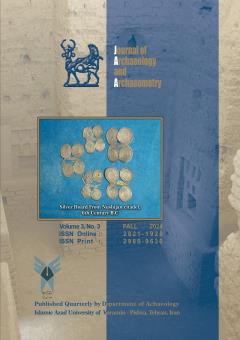Tepe Hissar in the Fourth Millennium BCE
Subject Areas : Archaeology
Neda Moradi
1
,
Hassan Fazeli Nashli
2
*
![]() ,
Rouhollah Yousefi Zoshk
3
,
Rouhollah Yousefi Zoshk
3
![]()
1 - Department of Archaeology, Science and Research Branch, Islamic Azad University, Tehran, Iran
2 - University of Tehran | UT · Department of Archeology. Tehran. Iran
3 - Department of Archaeology Faculty of Humanities Islamic Azad University of Varamin Tehran- Iran
Keywords: Tepe Hissar, Fourth Millennium BCE, Cultural Interactions, Pottery,
Abstract :
The fourth millennium BCE in northeastern Iran was marked by intricate interactions at both regional and trans-regional levels. During this time, Tepe Hissar’s inhabitants engaged in significant cultural exchanges involving pottery, figurines, and metal objects with various regions of central Iran. In the latter half of the millennium, these connections shifted towards northeastern Iran and the Gorgan Plain. Hissar became a hub for large-scale, centrally organized industries, particularly in metalworking and gemstone craftsmanship, such as lapis lazuli, which contributed to greater social stratification, evidenced by wealth accumulation in elite burials.New pottery chronologies offer a revised understanding of the cultural developments at the Hissar settlement and their social and cultural consequences, as seen in the material culture of settlements and burials. The primary goal of this research is to present the quantitative and qualitative changes in pottery and the influence of Tepe Hissar throughout the fourth millennium BCE. These changes indicate the formation of extensive internal and external cultural relationships, reflecting the cultural dynamism of Hissar during the fourth and third millennia BCE. It can likely be concluded that despite environmental heterogeneity in northeastern Iran, there were cultural homogeneities and similarities in this region. These can be observed in the resemblance of pottery styles and unified management techniques, which are attributed to cultural interactions between these communities within geographic and cultural frameworks.
Abassi, Q.A. (2007) Narges Tepe of the Gorgan Plain [in Persian]. In The 9th Annual Symposium on Iranian Archaeology. Archaeological Reports 7. Tehran: Iranian Center for Archaeological Research, pp. 247-261
Dyson, Robert H. Jr. (1987), "The Relative and Absolute Chronology of Hissar II and the Proto Elamite Horizon of Northern Iran, in Chronologies in the Near East, edited by O. Aurenche, J. Evin, and F. Hourse, pp: 647-678, B.A.R., Oxford.
Dyson, Robert H. Jr. and Susan Howard, (1989), Tappeh Hesār: Reports on the Restudy Project, 1976, Casa Editrice Le Lettere, Firenze.
Fazeli Nashli, Hassan, H. R. Valipour and M. H. Azizi Kharanaghi, (2013), the Late Chalcolithic and Early Bronze Age in the Qazvin and Tehran Plains: A chronological perspective, Ancient Itan and its Neighbours.
Gürsan-Salzmannn, A., (2016), The new chronology of the bronze age settlement of tepe hissar iran, University of Pennsylvania Museum of Archaeology and Anthropology Philadelphia,PA.
Helwing, Barbara, (20060, The rise and fall of Bronze age centers around the Central Iranian Desert- a comparison of Tappeh HissarII and Arisman, Archäologische Mitteilungen aus Iran und Turan 38:35-48.
Helwing, Barbara, (2013), some thoughts on the mode of culture change in the fourth-millennium BC Iranian highlands, ANCIENT IRAN AND ITS NEIGHBOURS.
Hessari, M., (2011), New Evidence of the Emergence of Complex Societies discovered on the Central Iranian Plateau.
Rezaei, Nami, Hoseini Qaleh, (2024) Typology and Iconography of the Seals of Tepe Hissar, Damghan, payam-e-bastanshenas, Issue 29 Vol. 15 Winter 2024.
Roustaei, Kourosh, (2004), Tappeh Hesār: A Major Manufacturing Centre at the Central Plateau, in Persiens Antike Pracht, Katalog der Ausstellung des Deutcher Bergbau-Museum Bochum in Verbindung mit der Iranischen Kulturerbe Organisation, edited by R.Slotta, T. Stöllner, and Rasould Vatandoust, pp: 25-34, Bochum.
Roustaei, Kourosh, (2010), Tepe Hesār, Once Again, in Proceedings of the 6th International Congress on the Archaeology of Ancient Near East, Vol 2, edited by Paolo Matthiae, Frances Pinnock, Lorenzo Nigro, and Nicolò Marchetti, Harrassowitz, Wiesbaden.
Schmidt, E.F. (1933) Tepe Hissar Excavations 1931. The Museum Journal, vol. 23.4. Philadelphia: The university museum.
Schmidt, E.F. (1937) Excavations at Tepe Hissar: Damghan. Philadelphia: The University. Museum.
Thornton. C. P, (2009), Archaeometallurgy: Evidence of a Paradigm Shift?
Thornton. C. P, (2013), The Bronze Age in Northeastern Iran.
Thornton. C.P, Th. Rehren, (2009), A truly refractory crucible from fourth millennium Tepe Hissar, Northeast Iran, Journal of Archaeological Science Volume 36, Issue 12, December 2009, Pages 2700-2712.
Thornton, Gürsan‐Salzmannn, and R. H. Dyson, (2013), "Tepe Hissar and the Fourth Millennium of Northeastern Iran" In (C. Petrie, ed.) Ancient Iran and its neighbours. London: Oxbow Books, pp. 131-144.

